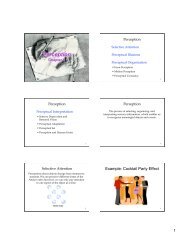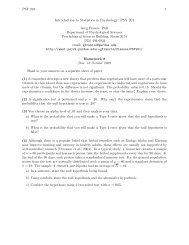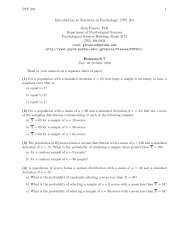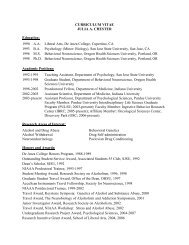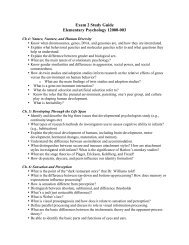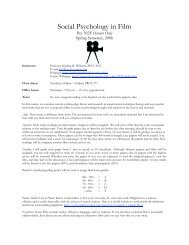Maxims or Myths of Beauty? A Meta-Analytic and Theoretical Review
Maxims or Myths of Beauty? A Meta-Analytic and Theoretical Review
Maxims or Myths of Beauty? A Meta-Analytic and Theoretical Review
You also want an ePaper? Increase the reach of your titles
YUMPU automatically turns print PDFs into web optimized ePapers that Google loves.
396 LANGLOIS ET AL.<br />
Subcateg<strong>or</strong>ies were academic/developmental competence, adjustment, in-<br />
terpersonal competence, <strong>and</strong> social appeal. Studies examining judgments<br />
about adults were typically global judgments <strong>of</strong> behavi<strong>or</strong>al traits <strong>and</strong><br />
personality characteristics made by other adults. Subcateg<strong>or</strong>ies were ad-<br />
justment, interpersonal competence, occupational competence, <strong>and</strong> social<br />
appeal. See Table 2 f<strong>or</strong> definitions <strong>and</strong> examples <strong>of</strong> each subcateg<strong>or</strong>y <strong>and</strong><br />
Appendixes C <strong>and</strong> D f<strong>or</strong> inf<strong>or</strong>mation about studies included in the<br />
meta-analysis.<br />
Treatment. This categ<strong>or</strong>y was defined as observable actions having <strong>or</strong><br />
thought to have actual impact on a target. The crucial criterion f<strong>or</strong> inclusion<br />
was that the measure must reflect actions toward a target by an agent. F<strong>or</strong><br />
example, actions such as punishing an attractive <strong>or</strong> unattractive child <strong>or</strong><br />
smiling directed toward an attractive <strong>or</strong> unattractive target were included in<br />
this categ<strong>or</strong>y.<br />
Studies investigating treatment <strong>of</strong> children focused on the actions <strong>of</strong><br />
peers, teachers, <strong>and</strong> caregivers. Subcateg<strong>or</strong>ies were attention/caregiving,<br />
designation <strong>of</strong> academic ability, 4 negative interaction, <strong>and</strong> positive inter-<br />
action. Studies examining treatment <strong>of</strong> adults typically included actions <strong>of</strong><br />
both adults <strong>and</strong> children in lab<strong>or</strong>at<strong>or</strong>y <strong>and</strong> naturalistic settings. Subcatego-<br />
ries were attention, help giving/cooperation, negative interaction, positive<br />
impression management, positive interaction, <strong>and</strong> reward (see Table 2 <strong>and</strong><br />
Appendixes E <strong>and</strong> F).<br />
Behavi<strong>or</strong>al Differences<br />
To separate conceptually distinct types <strong>of</strong> measures, we created two<br />
overall categ<strong>or</strong>ies f<strong>or</strong> behavi<strong>or</strong>al differences: behavi<strong>or</strong>/traits <strong>and</strong> self-<br />
perceived traits. All molecular measures <strong>of</strong> behavi<strong>or</strong> were classified as<br />
behavi<strong>or</strong>/traits (Ritter & Langlois, 1988). St<strong>and</strong>ardized psychometric mea-<br />
sures <strong>of</strong> traits (e.g., IQ tests) were also assigned to this categ<strong>or</strong>y because<br />
they have been validated as reasonably accurate measures <strong>of</strong> their con-<br />
structs. Furtherm<strong>or</strong>e, because experts (e.g., mental health pr<strong>of</strong>essionals)<br />
who make behavi<strong>or</strong>al assessments in their area <strong>of</strong> expertise should be<br />
unbiased <strong>and</strong> provide measures that are approximately equivalent in va-<br />
lidity to st<strong>and</strong>ardized measures, we included such measures in behavi<strong>or</strong>/<br />
traits. 5 Finally, we included measures <strong>of</strong> popularity in behavi<strong>or</strong>/traits<br />
because peers are, by definition, experts in judging whom they like.<br />
F<strong>or</strong> children, behavi<strong>or</strong>/traits were generally measured by observational<br />
<strong>or</strong> sociometric data <strong>and</strong> by st<strong>and</strong>ardized tests. Approximately 80% <strong>of</strong> the<br />
measures were based on observation <strong>of</strong> actual behavi<strong>or</strong>. Subcateg<strong>or</strong>ies<br />
included adjustment, intelligence/perf<strong>or</strong>mance, <strong>and</strong> popularity. F<strong>or</strong> adults,<br />
behavi<strong>or</strong>/traits were generally measured through observational studies,<br />
st<strong>and</strong>ardized tests, <strong>or</strong> molecular assessments <strong>of</strong> interaction behavi<strong>or</strong>. Ap-<br />
proximately 60% <strong>of</strong> the measures were based on observations <strong>of</strong> actual<br />
behavi<strong>or</strong>. Subcateg<strong>or</strong>ies were extraversion, intelligence, occupational<br />
success, mental health, physical health, popularity, self-confidence/self-<br />
esteem, social skills, traditional attitudes, dating experience, <strong>and</strong> sexual<br />
experience (see Table 2 <strong>and</strong> Appendixes G <strong>and</strong> H).<br />
In addition to using molecular measures, st<strong>and</strong>ardized measures, <strong>or</strong><br />
behavi<strong>or</strong>al/trait assessments by experts, many studies used global, unst<strong>and</strong>-<br />
ardized self-rep<strong>or</strong>ts <strong>of</strong> behavi<strong>or</strong>s <strong>and</strong> traits. We analyzed these measures<br />
because differential judgments <strong>and</strong> treatment may lead both to differential<br />
behavi<strong>or</strong> <strong>and</strong> to differential self-views as a function <strong>of</strong> attractiveness<br />
(Snyder etal., 1977). In addition, such measures may illustrate interesting<br />
differences between attractive <strong>and</strong> unattractive individuals. However, be-<br />
cause unst<strong>and</strong>ardized self-rep<strong>or</strong>ts are less objective than st<strong>and</strong>ardized mea-<br />
sures <strong>of</strong> traits <strong>and</strong> behavi<strong>or</strong>s, we created a separate categ<strong>or</strong>y f<strong>or</strong> them.<br />
Self-perceptions included two subcateg<strong>or</strong>ies f<strong>or</strong> adults, competence <strong>and</strong><br />
mental health. We were not able to analyze self-perceptions f<strong>or</strong> children<br />
because only a single study representing this categ<strong>or</strong>y was retrieved (see<br />
Table 2 <strong>and</strong> Appendix I).<br />
Classification Decisions<br />
Each potentially relevant article was reviewed by one <strong>of</strong> us <strong>and</strong> then<br />
presented to at least three others who were not familiar with the results<br />
<strong>of</strong> the study <strong>and</strong> who decided whether the study met inclusion criteria.<br />
Thus, knowledge <strong>of</strong> whether <strong>or</strong> not a study found a relation between the<br />
dependent variable <strong>and</strong> attractiveness could not influence the decision<br />
to include <strong>or</strong> exclude it. Each dependent variable was identified as<br />
representing one <strong>of</strong> the subcateg<strong>or</strong>ies within judgment, treatment, be-<br />
havi<strong>or</strong>/traits, <strong>or</strong> self-perceptions. Because we established clear coding<br />
criteria that left little room f<strong>or</strong> disagreement, there was almost complete<br />
consensus among us regarding overall categ<strong>or</strong>y classification. How-<br />
ever, in a few cases, there was not total consensus about what subcat-<br />
eg<strong>or</strong>y was measured by a particular dependent variable (e.g., is <strong>or</strong>der <strong>of</strong><br />
speaking in a group interaction a measure <strong>of</strong> social skills <strong>or</strong> extraver-<br />
sion?). We used the conceptual definition provided by the <strong>or</strong>iginal<br />
auth<strong>or</strong>(s) when available. When this was not available, we discussed to<br />
consensus.<br />
Effect sizes were coded so that a larger effect size indicated that<br />
attractive individuals received comparatively m<strong>or</strong>e treatment <strong>or</strong> had m<strong>or</strong>e<br />
<strong>of</strong> a particular trait <strong>or</strong> behavi<strong>or</strong> than unattractive individuals. To ensure<br />
accuracy, at least two <strong>of</strong> us verified effect size <strong>and</strong> variable coding, as well<br />
as data entry.<br />
Description <strong>of</strong> Moderat<strong>or</strong> Variables<br />
We coded characteristics <strong>of</strong> both the study participants <strong>and</strong> the studies<br />
themselves as potential moderat<strong>or</strong>s <strong>of</strong> attractiveness effects. Participant<br />
characteristics included gender <strong>and</strong> age. Study characteristics included year<br />
<strong>of</strong> publication, sample size, <strong>and</strong> the degree <strong>of</strong> familiarity between the target<br />
<strong>and</strong> the judge <strong>or</strong> the person behaving toward the target. Furtherm<strong>or</strong>e,<br />
because the type <strong>of</strong> attractiveness ratings used is <strong>of</strong> central imp<strong>or</strong>tance to<br />
our findings, we created a number <strong>of</strong> moderat<strong>or</strong> variables to expl<strong>or</strong>e effects<br />
<strong>of</strong> methodological differences on our findings. First, we coded whether the<br />
attractiveness ratings were obtained from photographs <strong>or</strong> videotapes, <strong>or</strong><br />
were done in situ (method: photo vs. video vs. in situt). Second, we coded<br />
whether the ratings were made from the face alone <strong>or</strong> whether the stimulus<br />
included any additional inf<strong>or</strong>mation, such as clothing (type: facial only vs.<br />
additional inf<strong>or</strong>mation). Third, we coded whether the study treated attrac-<br />
tiveness as a dichotomous variable <strong>or</strong> whether the study treated attractive-<br />
ness as a continuous variable (range: dichotomous vs. continuous). Finally,<br />
we coded whether the raters who made the attractiveness ratings also made<br />
judgments <strong>of</strong> other behavi<strong>or</strong>s <strong>and</strong> traits <strong>or</strong> whether the attractiveness raters<br />
were a separate, independent panel <strong>of</strong> judges. Inclusion <strong>of</strong> this variable was<br />
imp<strong>or</strong>tant because the "beauty is good" stereotype may bias raters evalu-<br />
ating both physical attractiveness <strong>and</strong> behavi<strong>or</strong> (raters: independent vs.<br />
nonindependent).<br />
4 We were unsure where to assign grades. Do grades reflect treatment by<br />
a teacher <strong>and</strong> belong in designation <strong>of</strong> academic ability? Or do they reflect<br />
attributes <strong>of</strong> the individual such as intelligence/perf<strong>or</strong>mance <strong>and</strong> belong in<br />
behavi<strong>or</strong>s/traits? F<strong>or</strong> high school <strong>and</strong> college students, who <strong>of</strong>ten are in<br />
larger classes <strong>and</strong> who take multiple-choice tests, grades probably reflect<br />
teachers' stereotypes less than they reflect actual ability <strong>of</strong> the student.<br />
Theref<strong>or</strong>e, we assigned grades <strong>of</strong> high school <strong>and</strong> college students to<br />
behavi<strong>or</strong>/traits. However, the issue f<strong>or</strong> young children is less clear. On the<br />
one h<strong>and</strong>, most so-called grades in elementary school are global assess-<br />
ments <strong>of</strong> excellent, satisfact<strong>or</strong>y, <strong>or</strong> unsatisfact<strong>or</strong>y rather than actual grades.<br />
Furtherm<strong>or</strong>e, some research has suggested that teacher expectations influ-<br />
ence grade assignments to elementary school children (Jussim & Eccles,<br />
1992). Theref<strong>or</strong>e, to be conservative in assessing children's ability, we<br />
initially assigned grades to differential treatment. However, we also ana-<br />
lyzed the data with grades <strong>of</strong> young children assigned to behavi<strong>or</strong>/traits, so<br />
the reader can decide f<strong>or</strong> her- <strong>or</strong> himself.<br />
5 See Note 4.<br />
6 Because there were only a few studies that used attractiveness ratings<br />
made in situ, we collapsed video <strong>and</strong> in situ into a single categ<strong>or</strong>y.





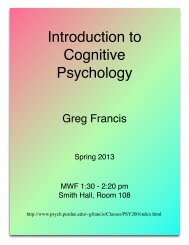
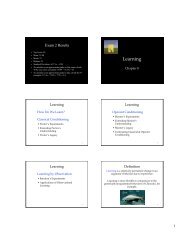
![Exam 4 Study Guide[1]](https://img.yumpu.com/45196739/1/190x245/exam-4-study-guide1.jpg?quality=85)
